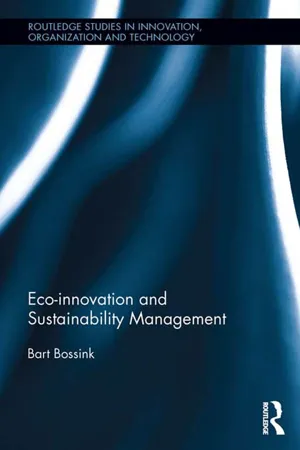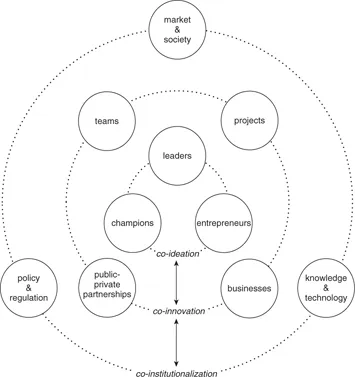![]()
1.1 INTRODUCTION
This book presents a model of eco-innovation and sustainability management. To researchers this model provides a coherent overview of the main elements of the eco-innovation and sustainability management system. It proposes, evaluates and discusses relationships among these elements. The model helps managers to decide which actions to take to develop eco-innovation and sustainability in commercial firms, not-for-profit organizations, nongovernmental organizations and governmental organizations.
This book defines eco-innovation and sustainability management as the development of new initiatives in an organization to sustain, improve and renew the environmental, social and societal quality of its business processes and the products and services these business processes produce. In this definition, the measures and targets of environmental, social and societal quality can have various dimensions, such as reduced pollution and limited use of natural resources; the provision of services not just to shareholders but to all stakeholders of the organization; and contributions to societal problems, including employment for the disabled and education for the untrained. In this book, the “sustainability” concept covers this broad array of issues.
The model in this book introduces three basic managerial levels for eco-innovation and sustainability: co-ideation, co-innovation and co-institutionalization. Co-ideation is defined as the cooperation of individuals who want to generate, develop and disseminate new sustainable thoughts, concepts, plans and suggestions for business. Co-innovation is defined as the cooperation of individuals who are situated in commercial organizations and who want to transform new sustainable thoughts, concepts, plans and suggestions for business into new viable, profitable and working business proposals in industry. Co-institutionalization is defined as the cooperation of individuals who are situated in commercial, not-for-profit, nongovernmental and governmental organizations and who want to create structural stimuli and arrangements that enable these new viable, profitable and working business proposals to become important in industry. The three managerial levels serve as the framework for the theory-building studies in this book. This book addresses questions such as these: What can personal leadership do for eco-innovation and sustainability? What is the role of entrepreneurs who invest and believe in eco-innovation and sustainability? What exactly can champions, that is, the persons who walk and talk innovation all the time, do for eco-innovation and sustainability? The studies in this book also elaborate on the contributions of teams, the functions of projects and project management, the embedding of teams and projects in firms and cooperation and partnerships among commercial firms, not-for-profit organizations, nongovernmental organizations and governmental organizations. It explores what these different forms of organization can do to improve ecological, social and societal quality. Finally, this book delves into the opportunities for people and organizations to institutionalize sustainable knowledge, revenues and achievements and create a powerful and large business that is eco-innovative and sustainable. It deals with the impact of markets, clients, customers, societal pressure groups, scientific and technological progress, and national policy and regulation.
This introductory chapter presents the three basic managerial levels of the model of eco-innovation and sustainability management (Section 1.2). It describes the methodology that is used to develop and build this model (Section 1.3). It compares the model with two other established models in the literature to put the characteristics into a broader theoretical perspective (Section 1.4). It concludes with a brief summary (Section 1.5).
1.2 THE ECO-INNOVATION AND SUSTAINABILITY MODEL
As stated in the introduction, this section introduces the three basic levels at which eco-innovation and sustainability management take place. The three levels are co-ideation, co-innovation and co-institutionalization. Cooperation is a key concept at all three levels. Co-ideation stands for all cooperative action of individuals to develop ideas with innovation potential in sustainability and that can be translated into effective solutions for business. Co-innovation is the cooperative activity of individuals in organizations to actually translate the ideas and solutions that originated at the co-ideation level into profitable businesses. Co-institutionalization is the cooperative effort of public and private parties to integrate the successful sustainable business proposals and businesses into the institutional environment and let the new emerging sustainable businesses grow into mature and widespread businesses with a large impact on industry and society.
The first of three starting points of this book is that eco- and sustainable innovation can be conceptualized as a linear process. The co-ideation level for eco-innovation and sustainability can be perceived as the start of the innovation process and that is followed by co-innovation and completed with co-institutionalization. Second, at the same time, this linear process can also be seen as cyclical, in the sense that the linear process goes on continuously,
Figure 1.1 The eco-innovation and sustainability system.
repeats itself over and over again and by this is a main driver of sustainable innovation and continuous improvement in organizations and society. Third, the eco- and sustainable innovation process can also be seen as interdependent, interactive and transformative, which means that aspects or elements of the different levels influence one another continuously. It implies that co-ideation drives co-innovation and co-innovation drives co-institutionalization but also that, in addition to this, co-innovation also drives co-ideation and co-institutionalization drives co-innovation. On top of this, several innovation cycles can occur at the same time and affect one another.
Figure 1.1 visualizes the model of linear, cyclic and interactive eco-and sustainable innovation through co-ideation, co-innovation and co-institutionalization. The three managerial levels in the system are symbolized by the dotted circles. The dotted circle in the center represents the co-ideation level. The surrounding dotted circle visualizes the co-innovation level. The outer dotted circle represents the co-institutionalization level. The double-headed arrows between the dotted circles visualize the linear, circular and interactive influence between these levels. The balls in the figure, situated on the dotted circles, visualize the elements at each level. The co-ideation level consists of leaders, champions and entrepreneurs; the co-innovation level consists of teams, projects, businesses and public-private partnerships; and the co-institutionalization level consists of market and society, knowledge and technology, and policy and regulation. This section briefly introduces these elements. The next chapters in this book are successively dedicated to one of these ten elements and delve into more details. The book concludes with a chapter that interprets the model as a whole.
Co-ideation
Three distinctive individual roles or personal behaviors play a pivotal role in the co-ideation process: the leader or leadership, the entrepreneur or entrepreneurship, and the champion or championship. The leaders, entrepreneurs and champions can be seen as the main drivers of the ideation process, that is, the development of ideas to innovate in sustainability. They also drive the co-ideation process by cooperating with one another and with other members of their organizations in order to share and further develop their thoughts and plans.
Leaders
Individual leadership directs a sustainable innovation team toward new creative ideas. To direct a creative process, the leader can choose from a repertoire of leadership styles and skills. A leader who wants to adopt a charismatic style, for example, can choose to energize colleagues to innovate and to have an accelerating effect on people's innovative activity (Murphy and Ensher, 2008; Paulsen, Maldonado, Callan and Ayoko, 2009). A leader can also be more oriented toward formal management instruments and put an emphasis on a strict structuring and control of sustainable innovation activities of workers in the firm (Abernethy, Bouwens and Van Lent, 2010). In addition, a leader who wants to act more strategically can use his or her hierarchical power base to motivate, force or direct teams to innovate in sustainability (Carmeli, Gelbard and Gefen, 2010). A leader can also choose to have frequent contact and cooperation with coworkers. A leader who likes to interact with colleagues can choose to empower others to innovate and to enable them to become sustainable innovation leaders themselves and help the official leader (Crevani, Lindgren and Packendorff, 2010).
Entrepreneurs
Not just leadership alone fuels the ideation process. It is also the entrepreneur or individual with entrepreneurial spirit who contributes to ideation and co-ideation. The entrepreneur can be seen as a main force behind the ideation strategies and processes in organizations. The entrepreneur, for example, can take the initiative to develop new products and services and can be the one who is constantly looking for new ways to make money. It is often mentioned that he or she always sees where new opportunities to sell products arise, “smells” where the opportunities for new services are hidden and starts projects and ventures to launch products and services and to open markets (Beveridge and Guy, 2005). It can be said that the entrepreneurial person is driven by the possibilities of successful innovation and is not scared by the risks of failure (Dixon and Clifford, 2007; Klein Woolthuis, 2009). In today's business landscape, socially driven entrepreneurship seems to be becoming a powerful alternative to gain strategic advantage, to mobilize resources, to raise the profile of the organizations involved and to generate income in new and emerging markets (Di Domenico and Haugh, 2007).
Champions
A third important driver of the ideation and co-ideation process is the innovation champion. Innovation champions are often seen as the creative drivers of innovative ideas and initiatives. An innovation champion, for example, endorses innovation by persuading others to join a project or, by means of a lobby, getting top management on board for an innovative venture. The champion of innovation talks innovation all the time (Kelley and Lee, 2010), has the expertise to innovate and likes to generate ideas (Sim, Griffin, Price and Vojak, 2007). The innovation champion processes information that generates new ideas, traces and shares knowledge and looks for the trends from which to derive new ideas (Coakes and Smith, 2007).
In the literature, these three types of individuals are judged to be the main drivers behind the ideation process of sustainable innovation. Cooperation among these three types and cooperation with other colleagues in the organization can contribute to the co-ideation process in the firm.
Co-innovation
Four organizational forms play a crucial role in the co-innovation process: the team, the project, the business and the public-private partnership. The work in and cooperation between individuals in teams, projects, businesses and public-private partnerships transform the ideas that originate at the co-ideation level into new sustainable and profitable business proposals. They also bring the ideas to the next level: the co-innovation level, where the ideas can be realized.
Teams
The leaders, entrepreneurs and champions of eco- and sustainable innovation need to cooperate with others in organizational settings. They need an organizational context; otherwise, their activities remain unnoticed. They, for example, need a team of generalists and specialists to adopt their ideas and develop these into new processes, products and services that actually change and rejuvenate business. An idea that is promoted by a leader, an entrepreneurial person or an innovation champion often has to be developed into something that can be made by the firm. This implies that a team of colleagues can be assigned by a company to structurally and coherently work on interesting ideas (Björkman, 2004; Hülsheger, Anderson and Salgado, 2009). They can be asked to separate the creative ideas with market potential from the ideas that will probably fail (Kratzer, Leenders and Van Engelen, 2006; Mathisen and Torsheim, 2006). Research indicates that an innovative team needs to be guided by a culture or spirit that supports the search for and discovery of practical ways to turn ideas into something that can be made by the firm (Adarves-Yorno, Postmes and Haslam, 2007; Martinsuo, 2009).
Projects
Often, projects are used as a main organizational form to structure a company's first attempt to develop a new innovative practice. A varied set of management principles can be applied to coordinate and control sustain-ably innovative activities in innovation projects. A project, for example, can start with a well-prepared project plan and use this as the basic outline for planning actions, deadlines and deliverables (Dorenbosch, Van Engen and Verhagen, 2005; Dougherty, 2008). In addition to this, a project organization can also choose to plan the innovations step by ...

